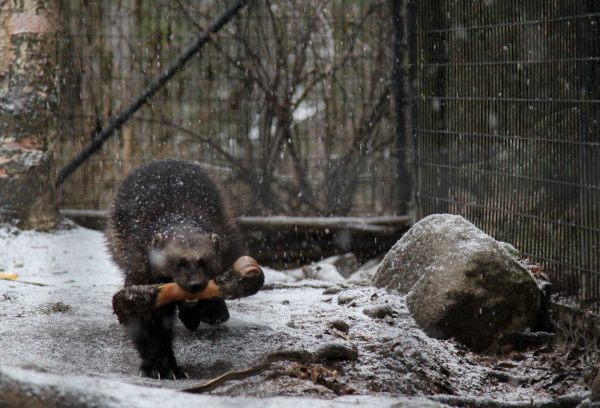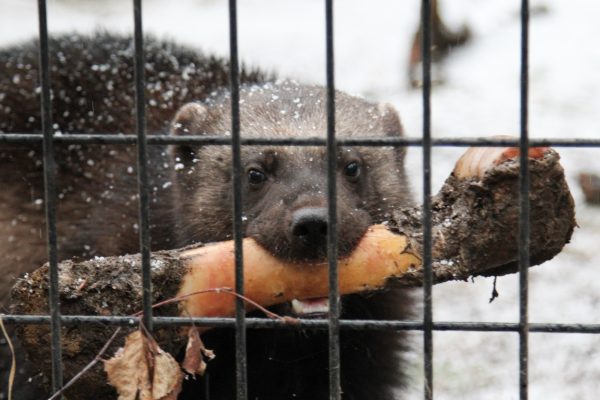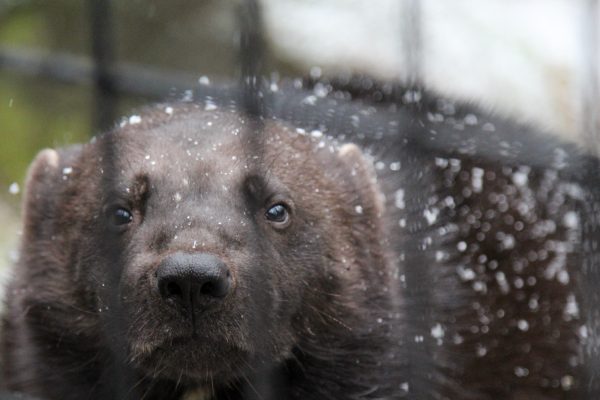
Jumbo the wolverine is 40.5 pounds of muscle. That’s almost twice the weight of his female companion, Olga. But she is the one who calls the shots.
“She’s a lot more possessive than he is,” said zookeeper Kerri Hancock, as Olga snarled mightily, guarding a buried bone. “She’s all bark, no bite.”
In recent weeks, a wild wolverine has made forays into Anchorage. Even though the animals are native to the area, with a thinly dispersed group spread around the Chugach mountains, sightings within the city are extremely rare.
“This wolverine has killed chickens and rabbits, and attacked at least one cat (the cat was uninjured),” the Alaska Department of Fish and Game wrote in a release last week. Many of the incidents happened in populous residential neighborhoods on the east side of Midtown, as Elmore Road heads south from Dowling toward O’Malley Road, an area abutting undeveloped, heavily wooded public lands.
So, how big of a threat is this for residents, especially those with small children and pets? And what should the public know about wolverines?
“Typically, wolverines don’t come into the city,” Hancock said of the notoriously reclusive and territorial species. “They don’t want to be in the city, they don’t want to be around anyone or anything.”
“I think that’s part of why people are so scared,” she added. “Because it’s never happened before. So the fact that it’s happening now, people are experiencing it for the first time. So it’s a new thing to worry about.”
Hancock is one of two zookeepers feeding the wolverine pair on a recent Saturday morning. The other is Kora Isakson, and their enthusiasm for wolverines is irrepressible.
Related: What’s driving Anchorage’s recent string of urban lynx encounters? Here’s what biologists say
“We’re not supposed to have favorites,” Isakson said. “But it’s hard to not adore them. That’s why when we heard there was a wolverine on O’Malley, we were like ‘Goodie!'”
According to the two keepers, relative to other wildlife that turn up within city limits, wolverines shouldn’t provoke worry. There’s no record of one attacking a human, unlike the bears that are more common within the municipal boundaries. They advise that if you spot a wolverine, give it space. Dispositionally, they are not timid, so trying to scare one away probably won’t work. They are also expert climbers and escape artists — so wily, in fact, that the entrances to their enclosures at the zoo have to be specially reinforced. Above a certain height, the trees are ringed with smooth metal sleeves to keep them from shimmying out. The keepers lamented that while they know how to keep them in, they are less certain how to keep them out. Specifically, out of chicken coops, yards, or rabbit hutches.
Opportunistic and voracious, in the wild they eat pretty much whatever they can get.
“The most common thing they catch are ground squirrels,” Isakson said. “They will catch birds on the ground, they’ll catch voles and mice and rabbits. Obviously, chickens if they’re available.”

Part of their intimidating reputation, though, comes from going after much larger prey.
“They’ve been known to take down caribou up north. And they can take down a moose. They look for them in the deep snow,” Isakson said. With broad paws studded with semi-retractable claws, wolverines can move atop snowpack that bogs down leggy ungulates. “So if a big moose is moving slow in the snow, they take that down.”
Expert diggers, wolverines have been observed caching whole caribou haunches in snow tunnels. They’ll trail wolf packs, scavenging their kills, even sometimes sparring with pack members over carcass scraps.
But you’d never guess any of that looking at Jumbo’s soft eyes as he nibbled meat hunks from Hancock’s fingers.

“They’re pretty gentle when they take meat like this through the fence,” she said.
Jumbo’s 40.5 pounds is at the very upper limit of normal wolverine weight. At 21 pounds, Olga is at the bottom of the range. The’re age 6 and 5, respectively. In captivity, wolverines can live up to 19 years, though in the wild it’s typically only until 10 or 11 years, according to Isakson.
One of Hancock’s favorite facts about wolverines is that they have a unique perpendicular molar in the back of their mouths that comes in handy for crunching through bone and tendon.
The animals are notoriously difficult for researchers to study, so less is known about them than their kin in the weasel family. Isakson believes that’s partly why they are so misunderstood by a public that often thinks of them as frenzied monsters.
“That’s where all this irrational fear comes from,” she said. “They’re no more scary than any other Alaskan wildlife. They’re known for being crazy, wild, ferocious beasts to watch out for. And they’re not.”
Isakson’s theory is that the wolverine wandering around Anchorage is a juvenile who recently left his parents’ care.
“It’s likely this is a super young, spunky wolverine, who has not learned caution yet, and is just exploring the world and having a fun time with it,” she said. “Looking for his own place to settle down.”
ADF&G asks that residents exercise caution letting pets out, and to report any wolverine sightings to its office, at 907-267-2257.
Zachariah Hughes reports on city & state politics, arts & culture, drugs, and military affairs in Anchorage and South Central Alaska.
@ZachHughesAK About Zachariah




